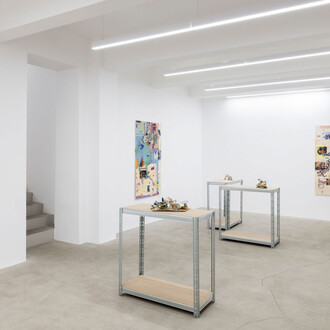These are Dangerous times. Plagued, for the most part, by invisible perils that affect and alter our life and perception: namely the insidious dangers of technology, disease, the new world. Borrowing the title from Bruce Cockburn's song "Lovers in a Dangerous time" (1984), we describe stubborn resistance, praising hope and beauty in an attempt to exorcise the darkness with light.
Only a few elements hover in the void of the gallery, however the select works of the five artists on exhibition are dense with meaning.
Michael Bevilacqua (1966-USA), Inma Femenia (1985-Spain), Michael Johansson (1975-Sweden), Stefan Milosavljevic (1992-Serbia), Sali Muller (1981- Luxembourg).
A small cube made up of glass objects, simply resting one on top of the other, as if placed by gravity, stands out – , fragile and easily threatened – as a sculptural representative of the era we live in. Titled "Crossfade-Fog", in just 25 cubic centimetres this work by Michael Johansson represents us all. Twenty-five centimetres of Us, our history, our fragile culture.
Rendering tensions and distortions visible in her rubber cords and folded aluminum plates, Inma Femenia warns us of the manipulations to which we are all subjected. It is digital technology that governs the new world, the world we are already experiencing, and above all, all that lies ahead.
Equally dangerous, yet far from intangible, is the violence that pervades our societies. Stefan Milosaljevic knew the harshness of war as a child and has had to learn to live with those memories. And it is from his elaboration of violence that his works burst forth. Indeed. in the installation exhibited at the San Fedele Gallery in 2017, the bombs of the war in Yugoslavia – as if captured by a child’s imagination – had already become beautiful fireworks. Now, in "Lovers in a Dangerous time", Milosaljevic presents a new installation in which numerous bullets are driven into the gallery wall, with delicate feathers bearing witness to their own explosion: the dichotomies of death-life, hate-love, Violence-pleasure once again guide his work.
In the darkness of night, Nature is anything but reassuring, just as the dark, acid-tinted flowers that stand out from the painting "Annihilation: the velvet Fold" by Michael Bevilacqua, are anything but reassuring. This is a garden where something dark hovers. A gaze, as pervasive as a virus, as sharp and threatening as a knife – the gaze of a being with androgynous features constitutes a wandering snare that makes these times even more dangerous. A recurring element in Bevilacqua's recent research, the silhouette of a hooded, almost ghostly man, whose face is never seen, outlines the anxiety-loaded sense of suspense that stares us down, silently pervading contemporary society.
There is however a 'gate' that “kicks at the darkness" (to cite the lyrics of the abovementioned song by Bruce Cockburn). It is a mirror that transcends time, reflecting the wonders of Sali Muller. Although it may appear to originate in the past, it carries the brightness of hope, gifting us a vision that brings the rainbow out from behind the clouds.
















